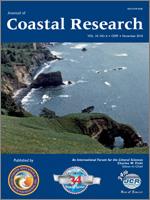Sherwood, C.R.; Warrick, J.A.; Hill, A.D.; Ritchie, A.C.; Andrews, B.D., and Plant, N.G., 2018. Rapid, remote assessment of Hurricane Matthew impacts using four-dimensional structure-from-motion photogrammetry.
Timely assessment of coastal landforms and structures after storms is important for evaluating storm impacts, aiding emergency response and restoration, and initializing and assessing morphological models. Four-dimensional multiview photogrammetry, also known as structure from motion (4D SfM), provides a method for generating three-dimensional reconstructions of landscapes at two times (before and after events) using only photos and existing information for ground control points. Here, these techniques were applied using National Oceanic and Atmospheric Administration (NOAA)-obtained oblique aerial photos taken before (2015) and immediately after Hurricane Matthew (2016) to assess coastal changes near Matanzas, Florida. This work demonstrated that 3D digital elevation models can be constructed within 48 hours of postevent photo collection without on-site ground control measurements. One advantage of timely SfM elevation-change assessments is that they avoid confusion of storm impacts with changes that occur after the event but before LIDAR surveys can be performed. The accuracy and precision of the 4D SfM maps were assessed a posteriori using the first-available LIDAR data, which were collected more than a month after the hurricane, and 11 independent ground-truth survey points measured a week after the hurricane. Horizontal coordinates of the 4D SfM reconstruction were biased by an average of 0.79 m (0.83 m root-mean-square difference; RMSD) compared with the ground-truth points, but vertical elevations were more accurate. They were biased from the LIDAR by −0.09 to −0.25 m, with ∼0.20 m RMSD from both the LIDAR data and five ground-truth points with good vertical positioning and 0.25 m RMSD from LIDAR data along a 60-m stretch of pavement. This level of precision was sufficient to quantify geomorphological change that was often in excess of 1 m. The methodology is conducive for rapid assessment of changes along short stretches (tens of kilometers) of coast with modest resources and could be scaled up for larger regions.





